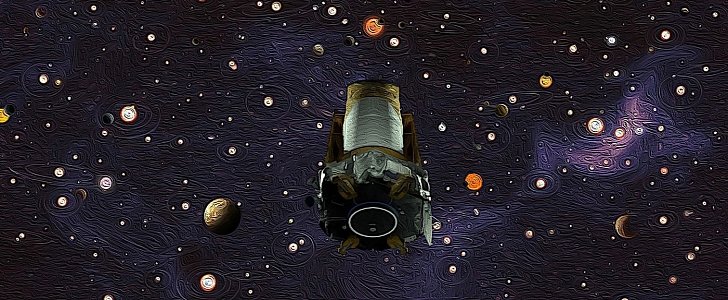With the Hubble space telescope making the headlines in recent weeks on account of its mechanical issues, humanity’s other eye in the sky, Kepler, has been taken off life support by NASA.
The American space agency announced on Tuesday the machine has run out of fuel and will be unable to perform further missions. As a result, the agency will be abandoning the spacecraft where it lies, in a heliocentric orbit.
But what does that mean for the telescope? Will it come crashing down on Earth? Will it aim for the Sun? Or will it spin forever into oblivion?
NASA’s Ames Research Center punched in the numbers to see what would happen to the telescope in the foreseeable future. Because, after all, there are only so many human-made objects in heliocentric orbit.
First off, it’s important to know that Kepler does not spin in orbit close to Earth, but rather at 94 million miles away. It also doesn’t spin around Earth, but around the Sun, just like all other planets do.
This pretty much means it’s impossible for the telescope to come crashing down to Earth, or into the Sun, for that matter. Instead, it will spin in a pattern that will bring it inside and outside of Earth’s orbit possibly forever.
NASA calculates that Kepler, because it travels on a larger, thus slower orbit than Earth, will almost be caught by by the blue planet sometimes around the year 2060. Such a huge rock coming near the telescope will change its orbit to one closer to the Sun, thus faster.
This means Kepler will move faster than the Earth, but only until for a century or so, as when it approaches Earth once more, the planet will kick it back to the previous, slower orbit.
And this dance could go on forever, as seen in the video attached below.
As it dances its sinusoidal dance with Earth, Kepler leaves behind a wealth of knowledge: over 2,600 planets discovered during its nine-year mission, “many of which could be promising places for life.”
But what does that mean for the telescope? Will it come crashing down on Earth? Will it aim for the Sun? Or will it spin forever into oblivion?
NASA’s Ames Research Center punched in the numbers to see what would happen to the telescope in the foreseeable future. Because, after all, there are only so many human-made objects in heliocentric orbit.
First off, it’s important to know that Kepler does not spin in orbit close to Earth, but rather at 94 million miles away. It also doesn’t spin around Earth, but around the Sun, just like all other planets do.
This pretty much means it’s impossible for the telescope to come crashing down to Earth, or into the Sun, for that matter. Instead, it will spin in a pattern that will bring it inside and outside of Earth’s orbit possibly forever.
NASA calculates that Kepler, because it travels on a larger, thus slower orbit than Earth, will almost be caught by by the blue planet sometimes around the year 2060. Such a huge rock coming near the telescope will change its orbit to one closer to the Sun, thus faster.
This means Kepler will move faster than the Earth, but only until for a century or so, as when it approaches Earth once more, the planet will kick it back to the previous, slower orbit.
And this dance could go on forever, as seen in the video attached below.
As it dances its sinusoidal dance with Earth, Kepler leaves behind a wealth of knowledge: over 2,600 planets discovered during its nine-year mission, “many of which could be promising places for life.”


